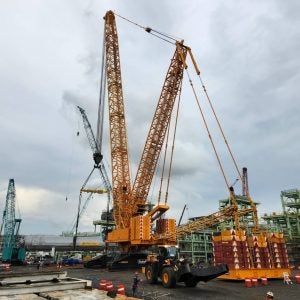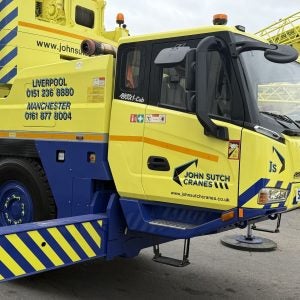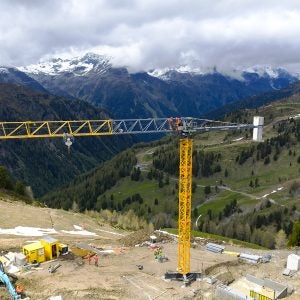Liebherr is displaying for the first time the new L1 series of hydraulic fast-erecting cranes which will be also awarded the main prize of the Crane Day competition at Bauma 2016. The company will also show four innovations from its mobile range, the LTM 1250-5.1 and the new eight-axle all terrains crane, and LR 1500 and LR 1100 crawlers. These new cranes feature innovations aim to make crane jobs particularly efficient.
The smallest series of self-erector cranes will support the type designation L1, reflecting the basic technical and design reworking of Liebherr’s hydraulic fast-erecting cranes. The name L1 is based on the first crane made by company founder Hans Liebherr in 1949.
Hans-Martin Frech, marketing and market management says: "The new L1 series combines innovative technology with a clear, modern design.
"The result is a powerful fasterecting crane which delivers improved ergonomics, excellent access for erection and maintenance work and a modern, attractive design," he adds. This new series of highly functional Liebherr cranes have been designed to deliver major benefits to building contractors due to its particular economy. The L1 hydraulic fast-erecting cranes match power and compact dimensions with maximum safety. After the market launch, the existing H series of cranes will gradually be substituted.
The first crane in the new series, the Liebherr L1-24, is available with a radius of either 25 m or 27 m and a maximum load capacity of 2,500 kg. There are two ballast versions available – simple standard concrete ballast or full steel ballast – which can be carried on the crane, therefore operator has no additional transport or erection costs.
"With a slewing radius of just 1.9 m, the new hydraulic fast-erecting crane is extremely adaptable on constricted sites," Frech says. "Thanks to the flexible support base, the crane’s footprint can be reduced to less than 4 metres. This means that there is often no need to close roads."
Its control equipment makes the Liebherr L1 easy to operate and safe to drive. In addition, the crane driver has several support functions such as Micromove fine positioning mode, oscillation damping and the operating range limiting system to help him with his work. These all enhance site safety, the company says.
Liebherr revealed the new crane to its dealers for the first time in October 2015 at its Spanish manufacturing plant in Pamplona. The new self-erector crane will be launched in stages, starting in Central Europe with an initial premier in March 2016.
The LTM 1250-5.1 has been designed to guarantee a maximum performance and it represents the most powerful mobile crane on five axles on the market. It is the third crane model with an innovative single-engine concept. The new crane includes a multi-functional folding jib and a 50 m hydraulically adjustable fixed jib is available, as well. The Liebherr VarioBase and ECOmode innovations allow crane operators to use the new LTM 1250-5.1 with even more safety and economy.
VarioBallast makes crane jobs particularly efficient in practice, operating with two different ballast radii at 5.58m or 4.78m. Liebherr has designed a solution to adjust the ballast radius in short time by 800mm, using standard mechanically changed ballasting cylinders. The large ballast radius delivers maximum load capacities whilst the small ballast radius let the crane be used in constricted site conditions, avoiding the use of smaller and less powerful mobile crane.
The crawler crane LR 1500 carries the load capacities of the 500t crawler crane class throughout its operating range whilst having the dimensions and component weights which have previously been normal in the 400t class. The new crane can be transported around the world without restrictions with a transport weight of just 45t. The overall concept of this crane is designed for simplicity in all areas and great economy.
The new Liebherr crawler crane is also planned to be simple to set up and operate, providing the powerful main hoist gear with its line pull of 180kN which can handle all hoists up to the maximum load capacity. This makes crane operation easier because there is no need for a second winch for dual operation for heavyweight hoists. Another winch with a rope hoist of 125kN is only needed if the crane is operated with a runner.
The entire lattice boom system is also notable for its simplicity, the company says. The number of parts and parts range on the new LR 1500 have been reduced to deliberately avoid using the otherwise standard divisions of lattice sections. In order to increase economy with the central ballast, the designers have come up with a solution: just a few concrete sections which can be set up quickly and whose top section forms a safe catwalk for the undercarriage. The eight-axle mobile crane with a very long telescopic boom will make its debute at the Bauma 2016 and it is focused on high economy and easy set-up on site.
The new LR 1100 concept for the 100-tonne class will be available worldwide from summer 2016. The newly designed steel fabrication of this crawler crane looks like a tubular structure and so has not only a high recognition factor, but also allows for optimum force transmission over short distances. This results in excellent lifting capacities even compared to the predecessor model in this class. These can be further enhanced by approximation 20% using a swinging counterweight which produces a higher stability with increased lifting capacities.
The LR 1100 is fitted with a powerful 230kW diesel engine complying with the exhaust emission standards stage IV / Tier 4f.
This new Liebherr crawler crane is extremely easy to transport and, moreover, excels in extremely quick set-up, the company says. The catwalks next to cabin and service areas are simply folded down for transportation instead of being laboriously dismounted. Boom foot and crawlers also remain on the crane during transportation.
Another innovation is the patented boom foot manipulator making it easy for haulage contractors to move the crane. Starting at the boom foot a rope is guided to a short auxiliary A-frame. Another rope leads from the A-frame to the counterweight cylinder. When this cylinder is extended, the counterweight leaves its stationary position and moves upwards, therefore there is no need for the big A-frame to be erected. It is a decisive advantage when entering low ship holds during shipping or when crossing under bridges on jobsites, the company says. In order to get the crawler crane ready for operation it is sufficient to mount the boom. Using the quick and easy set-up process the LR 1100 is ideal for flexible jobsite applications, as well.
With regards to the service and operating comfort, the position of the operator’s cab at a height of 2.3m provides an excellent overview of the complete jobsite. Moreover, orthopaedic operator seats as well as a modern climate control system contribute to increase comfort.
A spokesperson from Liebherr, Wolfgang Pfister says: "The new design of the LR 1100 facilitates service work. Compared to the predecessor model GRP doors on the uppercarriage are no longer required." "This facilitates optimum access for service personnel both from the ground and from the roof of the basic machine. Access is comfortable and safe thanks to the catwalks with optional handrails and a ladder."
In addition, the LR 1100 is equipped with the Litronic control system of the latest generation which is based on CANbus technology. The Litronic control concept is currently the only one on the market to manage without storage of load charts or interpolation of interim values.
In order to improve safety during the operation of crawler crane, two new assistance systems have been designed to contribute to higher comfort on the jobsite. The Vertical Line Finder ensures that the load on the rope is hoisted with perfect verticality. This prevents diagonal pull caused by the long distance between crane operator and load. Furthermore, this avoids asymmetric centres of gravity. The load does not start to sway which causes less wear to the boom and increases safety for the jobsite personnel, the company says. The second assistance system refers to the Horizontal Load Path which allows loads to be moved to the projected position more precisely following a horizontal line. "This is a decisive advantage especially in blind spots," Pfister says






